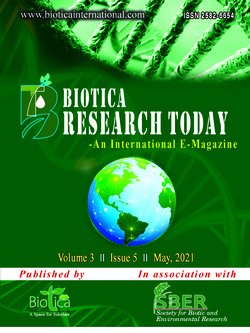
Methane and Its Reduction in Ruminants
Kamdev Sethy*
Dept. of Animal Nutrition, College of Veterinary Science and Animal Husbandry, Odisha University of Agriculture and Technology, Bhubaneswar, Odisha (751 003), India
D. Jena
Dept. of Animal Nutrition, College of Veterinary Science and Animal Husbandry, Odisha University of Agriculture and Technology, Bhubaneswar, Odisha (751 003), India
R. N. Babu
Dept. of Animal Nutrition, College of Veterinary Science and Animal Husbandry, Odisha University of Agriculture and Technology, Bhubaneswar, Odisha (751 003), India
S. K. Pradhan
Dept. of Animal Nutrition, College of Veterinary Science and Animal Husbandry, Odisha University of Agriculture and Technology, Bhubaneswar, Odisha (751 003), India
S. Tripathy
Dept. of Animal Nutrition, College of Veterinary Science and Animal Husbandry, Odisha University of Agriculture and Technology, Bhubaneswar, Odisha (751 003), India
DOI: NIL
Keywords: Global Warming, Methane, Mitigation, Ruminants
Abstract
Methane is a potent greenhouse gases responsible for global warming. Efforts have been made through research in last decade by the animal nutritionist for finding methods to reduce methane emissions. Since global warming potential of methane is 23 times higher than carbon dioxide, so reduction in methane emission can impact the global warming at early. The strategies should be lower methane production by our livestock. Various strategies like genetic selection for production traits, feeding of highly digestible forages, use of feed additives, rumen manipulation and ration balancing will reduce enteric CH4 emissions and cause an increase in animal performance by conserving energy and reducing feed costs associated with animal maintenance.
Downloads
not found
Reference
Steele, P., Fraser, P., Rasmussen, R., Khalil, M., Conway, T., Crawford, A., Gammon, R., Masarie, K., Thoning, K., 1987. The global distribution of methane in the troposphere. The Journal of Atmospheric Chemistry 5, 125-135.
Takenaka, A., Tajima, K., Mitsumor, M., Kajikawa, H., Osad, T., Kurihara, M., 2004. The measurement of hydrogen and methane gas using a semiconductor chip sensor. Proceedings of the workshop on the Science of Atmospheric Trace gases, NIWA Technical Report 125, 139-145.
Whitelaw, F. G., Eadie, W. J., Bruce, L. A., Shand, W. A., 1984. Methane formation in faunated and ciliate-free cattle and its relationship with rumen volatile fatty acid proportions. British Journal of Nutrition 52, 261-270.
